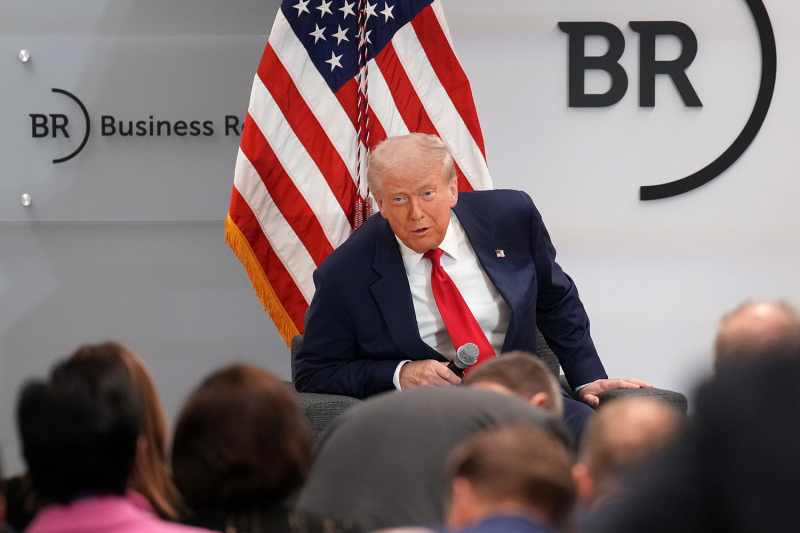Washington May Regret Overextended AI Chip Controls

Washington May Regret Overextended AI Chip Controls
Ever-tightening restrictions are boosting Chinese firms.
A Nvidia chip is displayed at the Mobile World Congress trade show in Shanghai on June 26, 2024. STR/AFP via Getty Images
On April 15, U.S. chipmaker Nvidia published a filing to the U.S. Securities and Exchange Commission indicating that the government has restricted the company from selling its less advanced graphics processing unit (GPU)—the H20—to China. The company is now required to obtain a license from the U.S. Commerce Department’s Bureau of Industry and Security to sell the H20 and any other chips “achieving the H20’s memory bandwidth, interconnect bandwidth, or combination thereof” to China, according to the filing.
Similarly, a filing from AMD stated that the firm is now restricted from selling its MI308 GPU to China—and likely any chips that have equal or higher performance in the future. Intel’s artificial intelligence accelerator Gaudi will also be restricted under the new control threshold, which reportedly appears to limit chips with total DRAM bandwidth of 1,400 gigabytes per second or more, input/output bandwidth of 1,100 GB per second or more, or a total of both of 1,700 GB per second or more.
On April 15, U.S. chipmaker Nvidia published a filing to the U.S. Securities and Exchange Commission indicating that the government has restricted the company from selling its less advanced graphics processing unit (GPU)—the H20—to China. The company is now required to obtain a license from the U.S. Commerce Department’s Bureau of Industry and Security to sell the H20 and any other chips “achieving the H20’s memory bandwidth, interconnect bandwidth, or combination thereof” to China, according to the filing.
Similarly, a filing from AMD stated that the firm is now restricted from selling its MI308 GPU to China—and likely any chips that have equal or higher performance in the future. Intel’s artificial intelligence accelerator Gaudi will also be restricted under the new control threshold, which reportedly appears to limit chips with total DRAM bandwidth of 1,400 gigabytes per second or more, input/output bandwidth of 1,100 GB per second or more, or a total of both of 1,700 GB per second or more.
The possible new threshold not only restricts the advanced chips that were already controlled but also the less advanced chips from Nvidia, AMD, and other chipmakers, including Nvidia’s H20, AMD’s MI308X, and Intel’s Gaudi, which were used to comply with the export control threshold and intended primarily for sale in the Chinese market.
The new restriction came roughly a week after NPR reported that the Trump administration had decided to back off on regulating the H20. Prior to that report, curbs on the H20 and chips with comparable performance had been widely anticipated by analysts on Wall Street, industry experts in Silicon Valley, and policy circles in Washington.
The latest set of chip controls could be seen as following on from export restrictions during the Biden administration and as continuation of the Trump administration’s efforts to limit China’s access to advanced AI hardware. But the new measure carries far-reaching industry implications that could fundamentally reshape the landscape of China’s AI chip market.
The impact of the new rule on the industry is profound. With the new controls, Nvidia is estimated to immediately lose about $15 billion to $16 billion, according to a J.P. Morgan analysis. AMD, on the other hand, faces $1.5 billion to 1.8 billion in lost revenue, accounting for roughly 10 percent of its estimated data center revenue this year.
Yet the implications go beyond immediate financial damage. If the restriction persists, it will fundamentally reshape the Chinese AI chip market landscape and mark the start of a broader retreat for U.S. AI accelerators from China. That includes not only GPU manufacturers such as Nvidia, AMD, and Intel but also firms providing application-specific integrated circuits—another type of chips targeting specific AI workloads, such as Google’s TPU and Amazon Web Servies’ Trainium.
The new rule will make it nearly impossible for U.S. firms such as Nvidia and AMD to design and sell chips that are export-compliant and competitive in the Chinese market. That means these firms’ market share in the Chinese AI chip market will decline over time, as they are forced to withdraw almost all of their offerings of both advanced and less advanced chips while Chinese firms gradually capture the remaining market.
The H20 and the upgraded H20E are already only marginally ahead of their Chinese competitors. Huawei’s latest AI chip Ascend 910C delivers 2.6 times the computational performance of the H20, although it offers 20 percent less memory bandwidth, which is vital for the inference training and reasoning models that are a key part of modern AI.
The H20’s memory bandwidth, along with Nvidia’s widely adopted software stack, a parallel computing platform and programming model that enables efficient GPU utilization for AI, high-performance computing, and scientific workloads, have been key differentiators driving demand from Chinese AI firms and keeping them competitive in the Chinese market. China acquired more than 1 million units of the H20 in 2024 and has been stockpiling the chip in response to looming concerns about controls since early 2025.
The narrowing gap between the H20 and Huawei’s 910C highlights the growing ability of Chinese AI chipmakers to meet domestic compute demand without foreign GPUs. As of today, Huawei’s 910C is in mass production, with units already delivered to customers and broader mass shipments reportedly starting in May. Most recently, Huawei is reportedly approaching customers about testing its enhanced version of the 910-series GPU—the 910D. Its next-generation chip—the Ascend 920—is expected to enter mass production in the second half of 2025.
Notably, Huawei is just one of many Chinese firms poised to fill the gap left by U.S. suppliers. Chinese AI chip companies such as Cambricon, Hygon, Enflame, Iluvatar CoreX, Biren, and Moore Threads are actively developing more competitive domestic AI chips to capture this expanding market.
Over the next few years, Chinese firms such as Alibaba, ByteDance, Baidu, and Tencent will likely continue to rely on existing inventories of Nvidia and AMD chips—such as the H100, H200, H800, and H20—acquired prior to the implementation of export controls. For example, ByteDance’s current GPU inventory in China is rumored to include 16,000-17,000 units of the A100, 60,000 units of the A800, and 24,000-25,000 units of the H800. Its overseas businesses likely have more than 20,000 units of the H100, 270,000 of the H20, and tens of thousands of cards such as the L20 and L40.
Advanced chips, including the limited amount of Nvidia’s Blackwell-series GPUs, may also continue entering the Chinese market via illicit or gray-market channels, given the enduring performance advantage and wide adoption of these chips over most Chinese domestic alternatives. The Blackwell GPUs and other cutting-edge chips could still be sold legally to the oversea data centers of leading Chinese AI companies to potentially train their AI models.
Similarly, other leading Chinese AI firms still possess significant chip stockpiles. Assuming export controls continue to restrict Chinese AI companies’ access to advanced computing resources, existing GPU inventories should still enable model development over the next several years. Typically, GPUs have a four- to five-year depreciation lifecycle, providing a window during which Chinese domestic GPU manufacturers can advance their capabilities and begin supplying more competitive chips to support domestic AI development.
Ultimately, time is now on the Chinese firms’ side. As inventories of foreign GPUs gradually depreciate and become obsolete, Chinese firms are expected to shift toward and adopt more domestically produced AI chips to meet ongoing compute needs at a time when local chipmakers offer more powerful alternatives. China’s overall computing demand will steadily rise, given the continued advancement of the AI industry, and such incremental growth in demand will likely be met by Chinese AI chipmakers.
As a result, the tens of billions of dollars in revenue that would have gone to Nvidia and AMD will be gradually captured by Chinese AI firms in the coming years. In a rough assessment, the latest ban causes Nvidia and AMD instant losses of about $16.5 billion to $17.8 billion—about 70 percent of what Huawei spent on research and development in 2024.
This new market paradigm will not only strengthen the market position and financial sustainability of domestic Chinese AI chipmakers but also enhance their capacity to reinvest in R&D. In turn, this will accelerate innovation, improve competitiveness, and fortify China’s broader AI hardware supply chain—ultimately contributing to the long-term resilience and advancement of Chinese AI capabilities.
More importantly, the growing domestic adoption of Chinese GPUs enables local firms to refine their products more efficiently through accelerated and larger feedback loops from local enterprises. As the Nvidia-led GPU ecosystem stalls and gradually retreats from the Chinese market, this shift creates space for local players to build a domestic GPU ecosystem—one that may increasingly lock out foreign competitors and raise re-entry barriers over time.
A total ban on the H20 would likely slow China’s short-term growth in AI compute capacity by removing a key source of advanced chips. But the medium- to longer-term impact is less clear. Chinese AI companies, as previously noted, remain very capable of developing their AI by using a large number of existing Nvidia and AMD GPUs for the next few years, alongside a growing supply of improving domestic alternatives. The U.S. leadership’s ultimate goal of using export controls to constrain China’s AI development remains uncertain, as the gap between the two countries’ AI model capabilities appears to be narrowing rather than widening.
What is clear, however, is the broader industry impact of the new controls. If sustained, they will mark the beginning of a major withdrawal of U.S. AI chipmakers from the Chinese market—paving the way for a significant boost to domestic Chinese AI chipmakers. In trying to isolate China, the United States may end up giving Chinese firms a leg up.
Ray Wang is a Washington-based analyst formerly based in Taipei and Seoul. He focuses on U.S.-China economic and technological statecraft; Chinese foreign policy; and the semiconductor and AI industry in China, South Korea, and Taiwan.
More from Foreign Policy
-

A drawn illustration of a Trump whirlwind on a red background Four Explanatory Models for Trump’s Chaos
It’s clear that the second Trump administration is aiming for change—not inertia—in U.S. foreign policy.
-

Marco Rubio is seen up close, sitting on a couch beside J.D. Vance. Marco Rubio’s Soulless Crusade
The U.S. secretary of state stands for no principle other than serving the man who appointed him.
-

Soldiers from various NATO allies take part in a military exercise at the Smardan Training Area in Smardan, Romania, on Feb. 19. America Will Miss Europe’s Dependence When It’s Gone
European self-reliance for security will cost U.S. jobs, profits, and influence.
-

A collage photo illustration shows Donald Trump gesturing with arms wide. In front of him are headshots of Benjamin Netanyahu and Vlodymyr Zelensky, images of immigratns and ICE police, a tattered EU flag and America First signs. Trump’s First 100 Days on the Global Stage
Ten thinkers on what to make of the opening salvo of the president’s second term.







Join the Conversation
Commenting on this and other recent articles is just one benefit of a Foreign Policy subscription.
Already a subscriber?
.
Subscribe
Subscribe
View Comments
Join the Conversation
Join the conversation on this and other recent Foreign Policy articles when you subscribe now.
Subscribe
Subscribe
Not your account?
View Comments
Join the Conversation
Please follow our comment guidelines, stay on topic, and be civil, courteous, and respectful of others’ beliefs.
Change your username |
Log out
Change your username:
CANCEL
Confirm your username to get started.
The default username below has been generated using the first name and last initial on your FP subscriber account. Usernames may be updated at any time and must not contain inappropriate or offensive language.